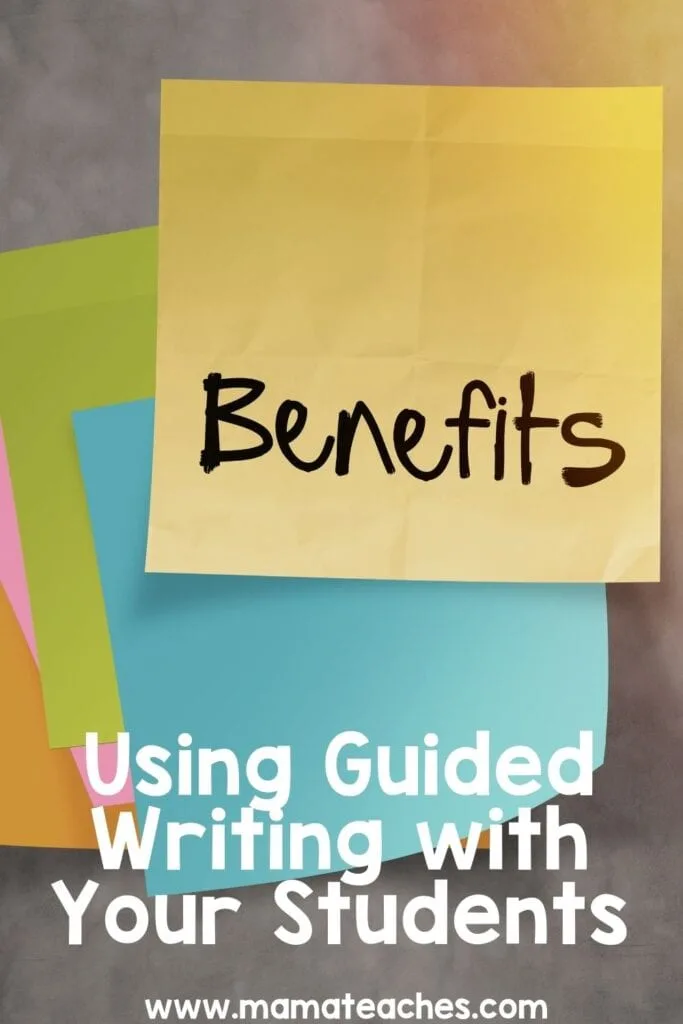You want your students to become better writers, but how do you get them there?
They need individualized and focused attention from you in the form of guided writing.

This article contains affiliate links to things that you might like.
What Is Guided Writing?
Guided writing involves meeting with an individual student or a small group of students (no more than 6) who need to work on the same writing issue.
Through pictorial prompts or special assignments, the students will compose their own sentences or paragraphs for informal three-fold assessment (by peers, teacher, and self).
Benefits of Guided Writing
Guided writing gives the teacher a chance to observe the student in the process of writing.
You can learn a lot from this: What are the common errors a student makes?
What does she do well?
Guided writing gives you a chance to address a mistake and help train a student’s thinking to prevent those kinds of mistakes in the future.
This type of individualized attention is impossible in the larger class setting.
Guided writing can also provide a supportive and encouraging atmosphere for reluctant or insecure writers.
By hearing the positive feedback of her teacher and peers, a budding writer may be prompted to write and share more willingly.

How to Do Guided Writing with Your Students
Guided writing can be done with almost any age of writer, from early elementary to high school.
The same simple steps are loosely followed.
Step 1: Form the Group and Pick the Focus
You want a group of writers (remember, no more than 6) who are basically on the same level or struggling with the same focus issue.
What is the focus of your guided writing session?
Is it choosing the correct ending punctuation, adding details to informational writing, or using more active and vibrant verbs?
Step 2: Develop the Prompt
With younger students, picture prompts work well.
Older students may respond to oral directions (e.g, “Write a simile about how quickly Jack runs.” or “Compose a descriptive paragraph about a cake that uses words that appeal to all 5 senses.”
Step 3: Find a Quiet Place
Form a writing circle in a place as free from distraction as possible.
This may be merely a corner of the classroom, but do your best to create an environment where the students can concentrate.
Step 4: Set the Tone
Explain that this is a time to practice a writing skill.
Tell the students the writing assignment will be short, and that it will be followed by a time of feedback to help and encourage them.
Keep the pressure off; guided writing should be low stress.
Step 5: Give the Prompt and Some Time to Work
Explain the prompt and allow the students time to compose.
You may wish to take notes on what you see.
Step 6: Give Feedback
Take turns sharing the compositions.
After each student shares, you may wish to ask peers to give some feedback.
This feedback should always be specific and largely positive.
I like to ask for a glow and a grow.
The “glow” is what the student did well. The “grow” is how they could improve for next time.
After the student’s peers have given their feedback, you give yours (also following the glow and grow model).
For example, if the focus is ending punctuation, you could say, “You did a great job remembering to put a punctuation mark at the end of each sentence.
For next time, remember that command sentences should end with periods or exclamation marks.”
Step 7: Have the Writer Reflect
It is always helpful to end with the writer assessing herself along the same framework: glow and grow. After receiving feedback from her teacher and peers, the student has many ideas.
Ask her, “What did you do well?” Then, “What would you like to work on for next time?” Make a note of what she chooses to work on; you can look for this in her future writing assignments.

Guided Writing Topics
Guided writing topics and focuses will vary by age.
Picture prompts are an excellent tool to use with any of these focuses.
Find a dynamic picture from a storybook, comic strip, or magazine.
Crop and copy the picture so there are no words or text on the page.
Have the students study the picture as you give the prompt.
For example, if your focus is writing direct quotations with correct capitalization and punctuation, say,
“Write do you think this character will say next?”
Mechanics
- Capitalization of proper nouns
- Capitalizing the first word in sentences
- Direct and indirect quotations
- End marks
- Forming compound sentences
- Using contractions
- Writing complete sentences (avoiding fragments and run-ons)
Style
- Avoiding overly wordy sentences
- Using strong verbs
- Adding quality adjectives
- Varying sentence patterns
- Including parallel words, phrases, or clauses
- Metaphors, similes, personification, etc.
Structure
- Writing a topic sentence
- Adding a great concluding sentence
- Outlining
- Adding details to informational writing
- Creating vivid descriptions
- Composing dialogue
Sample Topics
- Write a dialogue that does not use the word said.
- Write a paragraph with all four sentence purposes: declarative, exclamatory, interrogative, and imperative.
- What is the best/worst vegetable? Write a paragraph with a strong topic sentence and three supporting reasons.
- Describe your favorite animal from tip to tail, using quality adjectives that help me picture it in my mind.
- Write 5 simple sentences about whales. Then join two of them together to make a compound sentence.

Using Guided Writing with Students
Writing is not a gift; it’s a skill.
Skills must be taught and practiced.
Guided writing allows you to tailor your writing instruction to the individual needs of your students.
Try it!
Then watch your young writers blossom.
